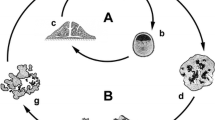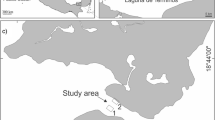Abstract
Sediment deposition is known to affect the structure of marine rocky-bottom communities, but its specific effects on some key organisms, such as sponges, remain poorly investigated. In a 125-day field experiment involving different treatments of exposure to sediment deposition, we investigated survival of asexually produced recruits of the sublittoral demosponge Scopalina lophyropoda, a model organism suitable to understand similar processes in other sponges. A total of 660 explants obtained from 11 non-clonal sponges (explant donors) were distributed on 30 experimental plates. Each donor sponge contributed two clonal explants per plate, one settled under a roof at a silt-protected position and the other at a silt-exposed position. Plates were installed at the rocky walls of the natural community, also at the pillars of a local harbor where the sponge does not occur naturally. A 3-way ANOVA testing for differences in explant longevity as a function of explant donor, exposure to sediment, and habitat detected that longevity was affected by both an undetermined genetic condition of the explant donor and exposure to silt. Silt-protected explants lived longer than silt-exposed explants. A significant “Silt-exposure × Habitat” interaction detected that silt-exposed explants lived shorter within the harbor than in the natural community, suggesting that harbor silt, which was notably finer, is more deleterious. Inspection of daily mortality rates revealed that the detrimental effects of silt were very evident during the first 20 days in treatments and irrespective of habitat. Then, mortality rates progressively decreased, reaching negligible values in all 4 sponge groups by day 65. At this stage, an undetermined mortality factor other than purely sediment deposition reactivated mortality in all 4 sponge groups, but it affected more intensely the sponges in the harbor, irrespective of being protected from or exposed to sediment deposition. All together, the results of our field experiment suggest that sediment loads are a major mortality factor among small sponge individuals in sublittoral rocky communities. Because a significant “donor factor” suggests an unidentified “genetic component” to be involved in the ability to cope with sediment, natural or man-driven processes increasing coastal sediment deposition are susceptible to induce changes not only in the abundance but also the genetic structure of the sponge populations in the long term.







Similar content being viewed by others
References
Airoldi L (2003) The effects of sedimentation on rocky coast assemblages. Oceanogr Mar Biol Ann Rev 41:161–236
Ballesteros E (1989) Production of seaweeds in Northwestern Mediterranean marine communities: its relation with environmental factors. Sci Mar 53(2–3):357–364
Baynes TW (1999) Factors structuring a subtidal encrusting community in the southern Gulf of California. Bull Mar Sci 64:419–450
Bell JJ, Barnes DKA (2000) The influence of bathymetry and flow regime upon the morphology of sublittoral sponge communities. J Mar Biol Assoc UK 80:707–718
Blomqvist S, Häkanson L (1981) A review on sediment traps in aquatic environments. Arch Hydrobiol 91:101–132
Cebrian E, Agell G, Martí R, Uriz MJ (2006) Response of the Mediterranean sponge Chondrosia reniformis Nardo to copper pollution. Env Pollut 141:452–458
Cebrian E, Martí R, Uriz MJ, Turon X (2003) Sublethal effects of contamination on the Mediterranean sponge Crambe crambe: metal accumulation and biological responses. Mar Pollut Bull 46:1273–1284
Curtis ASG, Kerr J, Knowlton N (1982) Graft rejection in sponges. Genetic structure of accepting and rejecting populations. Transplantation 30:127–133
Duggins DO, Eckman JE, Sewell AT (1990) Ecology of understory kelp environments. II. Effects of kelps on recruitment of benthic invertebrates. J Exp Mar Biol Ecol 143:27–45
Fox GA (1993) Failure-time analysis: Emergence, flowering, survivorship, and other waiting times. In: Scheiner SM, Gurevitch J (eds) Design and analysis of ecological experiments. Chapman & Hall, New York, pp 253–289
Gaines SD, Roughgarden J (1985) Larval settlement rate: a leading determinant of structure in an ecological community of the marine intertidal zone. Proc Natl Acad Sci USA 82:3707–3711
Glasby TM (1999) Interactive effects of shading and proximity to the seafloor on the development of subtidal epibiotic assemblages. Mar Ecol Prog Ser 190:113–124
Harmelin JG (1985) Organisation spatiale des communautés sessiles des grottes sous-marines de Méditerranée. Rapp CIESM 29(5):149–153
Hildemann W, Johnson I, Jokiel P (1979) Immunocompetence in the lowest metazoan phylum: transplantation immunity in sponges. Science 204:420–422
Hurlbut CJ (1991) The effects of larval abundance, settlement and juvenile mortality on the depth distribution of a colonial ascidian. J Exp Mar Biol Ecol 150:183–202
Ilan M, Abelson A (1995) The life of a sponge in a sandy lagoon. Biol Bull 189:363–369
Irving AD, Connell SD (2002) Sedimentation and light penetration interact to maintain heterogeneity of subtidal habitats: algal versus invertebrate dominated assemblages. Mar Ecol Prog Ser 245:83–91
Jokiel PL (1980) Solar ultraviolet radiation and coral reef epifauna. Science 207:1069–1071
Lee ET (1980) Statistical methods for survival data analysis. Lifetime Learning, Belmont, CA
Lesser MP (1996) Elevated temperature and ultraviolet radiations cause oxidative stress and inhibit photosynthesis in symbiotic dinoflagellates. Limnol Oceanogr 41:271–283
Lohrer AM, Hewitt JE, Thrush SM (2006) Assessing far-field effects on terrigenous sediment loading in the coastal marine environment. Mar Ecol Prog Ser 315:13–18
Maldonado M (2002) Family Pachastrellidae Carter, 1875. In: Hooper JNA, Van Soest RWM (eds) Systema Porifera: A guide to the classification of sponges. Kluwer Academic/Plenun Publisher, New York, pp 141–162
Maldonado M (2006) The ecology of the sponge larva. Can J Zool 84:175–194
Maldonado M, Carmona MC, Velásquez Z, Puig A, Cruzado A, López A, Young CM (2005) Siliceous sponges as a silicon sink: an overlooked aspect of the benthopelagic coupling in the marine silicon cycle. Limnol Oceanogr 50(3):799–809
Maldonado M, Uriz MJ (1998) Microrefuge exploitation by subtidal encrusting sponges: patterns of settlement and post-settlement survival. Mar Ecol Prog Ser 174:141–150
Maldonado M, Uriz MJ (1999a) Sexual propagation by sponge fragments. Nature 398:476
Maldonado M, Uriz MJ (1999b) An experimental approach to the ecological significance of microhabitat-scale movement in an encrusting sponge. Mar Ecol Prog Ser 185:239–255
Maldonado M, Young CM (1996) Bathymetric patterns of sponge distribution on the Bahamian slope. Deep-Sea Res I 43(6):897–915
Mariani S, Uriz MJ (2001) Copepods of the genus Asterocheres (Copepoda: Siphonostomatoida) feeding on sponges: behavioral and ecological traits. Invert Biol 120:269–277
Maughan BC (2001) The effects of sedimentation and light on recruitment and development of a temperate, subtidal, epifaunal community. J Exp Mar Biol Ecol 256:59–71
Paine RT (1990) Benthic macroalgal competition: complications and consequences. J Phycol 26:12–17
Péres JM, Picard J (1964) Nouveau manuel de bionomie benthique de la mer Méditerranée. Rec Trav Stn mar Endoume 31(47):1–137
Peterson CH, Black R (1987) Resource depletion by active suspension feeders on tidal flats: Influence of local density and tidal elevation. Limnol Oceanogr 32(1):143–166
Preciado I, Maldonado M (2005) Reassessing the spatial relationships between sponges and macroalgae in sublittoral rocky bottoms: a descriptive approach. Helg Mar Res 59:121–135
Reiswig HM (1971) Particle feeding in natural populations of three marine demosponges. Biol Bull 141:568–591
Richter C, Wunsch M, Rasheed M, Kötter I, Badran MI (2001) Endoscopic exploration of Red Sea coral reefs reveals dense populations of cavity-dwelling sponges. Nature 413:726–730
Ros J, Romero J, Ballesteros E, Gili JM (1985) Diving in blue water. In: Margalef R (ed) Western Mediterranean. Pergamon, Oxford, pp 233–295
Rützler K, Díaz MC, van Soest RWM, Zea S, Smith K, Alvarez B, Wulff JL (2000) Diversity of sponge fauna in mangrove ponds, Pelican Cays, Belize. Atoll Res Bull 477:231–250
Sarà M, Vacelet J (1973) Ecologie des Démosponges. In: Grassé PP (ed) Spongiaires. Anatomie, physiologie, systématique, ecologie. Masson et Cíe, Paris, pp 462–576
Scheffers SR, Niewland G, Bak RPM, van Duyl FC (2004) Removal of bacteria and nutrient dynamics within the coral reef framework of Curaçao (Netherlands Antilles). Coral Reefs 23:413–422
Schmidt O (1862) Die Spongien des Adriatischen Meeres, Leipzig
Tanner JE (1995) Competition between scleractinian corals and macroalgae: An experimental survey investigation of coral growth, survival and reproduction. J Exp Mar Biol Ecol 190:151–168
Underwood AJ (1975) Comparative studies on the biology of Nerita atramentosa Reeve, Bembicium nanum (Lamarck) and Cellana tramoserica (Sowerby) (Gastropoda: Prosobranchia) in S.E. Australia. J Exp Mar Biol Ecol 18:153–172
Vacelet J (1976) Les spongiaires des grottes sous-marines obscures de la Méditerranée et des régions tropicales. P S Z N Mar Ecol 40:506–515
Valiella I (1995) Marine ecological processes. Springer, New York
Wentworth W (1972) A scale grade and class term for clastic sediments. J Geol 30:377–389
Werding B, Sánchez H (1991) Life habitats and functional morphology of the sediment infaunal sponges Oceanapia oleracea and Oceanapia peltata (Porifera, Haplosclerida). Zoomorph 110:203–208
Wilkinson CR, Vacelet J (1979) Transplantation of marine sponges to different conditions of light and current. J Exp Mar Biol Ecol 37:91–104
Wulff JL (1986) Variation in clone structure of fragmenting coral reef sponges. Biol J Linn Soc 27:311–330
Zea S (1993) Recruitment of Demosponges (porifera, Demospongiae) in Rocky and Coral Reef Habitats of Santa Marta, Colombian Caribbean. P S Z N Mar Ecol 14:1–21
Acknowledgments
The authors thank CEAB technicians I. Abreu for logistic help his during field work and G. Carreras for help with the sediment analyses. Two anonymous reviewer are thanked for their constructive comments. This study was funded by a fellowship of the Spanish Agency for International Cooperation (AECI) and a grant of the Spanish Ministry of Science and Education (CTM2005-05366/MAR). The experiments comply with the current laws of Spain.
Author information
Authors and Affiliations
Corresponding author
Additional information
Communicated by U. Sommer.
Rights and permissions
About this article
Cite this article
Maldonado, M., Giraud, K. & Carmona, C. Effects of sediment on the survival of asexually produced sponge recruits. Mar Biol 154, 631–641 (2008). https://doi.org/10.1007/s00227-008-0956-5
Received:
Accepted:
Published:
Issue Date:
DOI: https://doi.org/10.1007/s00227-008-0956-5




